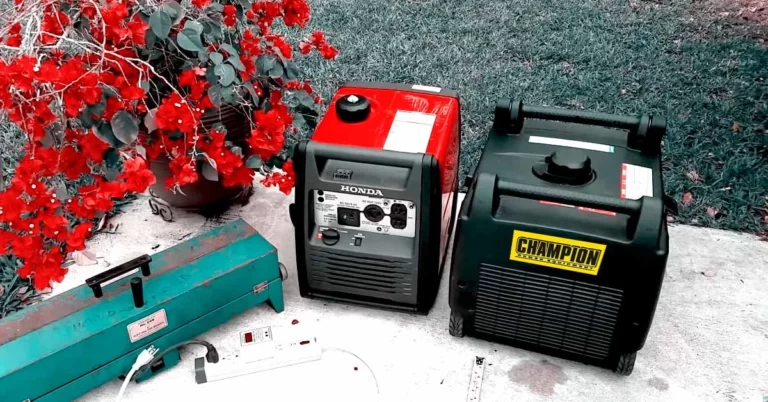How To Test A Generator?
We all understand the importance of generators as emergency or backup power sources. Like any machinery, generators require maintenance and testing before they’re needed. Before any emergency arises, conducting various tests on your portable, inverter, or solar generator is crucial to ensure readiness, especially for hurricane season. In this discussion, we will outline different tests and guide How To Test A Generator, including output tests, load tests, runtime duration tests, insulation resistance tests, and voltage AVR tests. Keep reading to learn more.
How To Test a Generator in Different Ways?
How can you assess a generator’s performance? There are five distinct methods for evaluating your generator:
How To Check Generator Output Test?
To test a generator, connect it to a load bank, measure voltage and frequency, adjust settings for correct output, monitor performance, and troubleshoot if needed. Passing means it’s suitable for powering equipment.
Start Your Generator
Start your generator by turning on the power switch or pulling the recoil cord if it’s equipped with one. If it doesn’t begin initially, try adjusting the choke to halfway or fully and ensure the fuel line is open before starting it again. After To begin, follow these steps to inspect the generator’s output:

- Now, utilize a voltmeter to measure the voltage. Set the voltmeter to the AC voltage position, usually marked as “ACA,” “ACV,” “A~,” or “V~.”
- Attach the black cable to the voltmeter, securing the alligator clip to the generator’s frame. This safeguards against power surges. If your cable lacks an alligator clip, acquire one for securing.
- Connect your voltmeter’s red cable to the generator’s output for voltage measurement. Generators have various outlets, such as 120 and 220 volts, which you can test similarly.
- Once the voltmeter is connected to your generator, it will display the voltage in numbers. Insert the voltmeter’s red lead into the output plug, whether 120V or 220V. If the displayed voltage matches your expectations, it’s okay; otherwise, it may require your attention.
- In the end, disconnect the voltmeter cable and power down the generator using the ignition or power switch.

How To Check Generator Load Test?
Check Fluid levels and Coolant Levels
Before you test the generator with a load test, verify fuel and oil levels. In the case of water-cooled generators, ensure the coolant level is approximately 1 inch below the top.
Generator Run At Full Speed
Initiate the generator and set it to full speed. If you encounter issues like clunking or sputtering noises, address and resolve them before proceeding with the test.
Test Load Bank Into the Generator
To test a generator, you need a load bank to simulate a load. Connect the load bank to the generator’s output using a cable. You can rent a portable load bank for testing or purchase one if you have multiple generators and require frequent load testing.
Turn On the Circuit Breaker
Now, flip the generator’s control panel switch to the ON position to enable power from the generator to flow to the load bank.
Switch On for Full Power
To find out how much the generator can handle, follow these steps:
- Begin with the biggest load on the load bank.
- Add smaller loads one by one.
- Keep doing this until the generator can’t take any more.
For example, if the generator can handle 60 amps:
- Start with a 30-amp load.
- Then, add 20-amp load
- At last, add two 10-amp loads.
While adding loads, you might hear the engine getting louder, which is normal. But if you hear strange sounds from the generator, stop it to stay safe.
Monitor Load Test Duration
Duration for a generator test can differ depending on the type and why you’re testing it.
While you’re testing it, keep the power steady and watch things like voltage, how much electricity it’s making, and how fast it’s working using a particular machine called a load bank.
Heavy-duty portable generators need 4-8 hours. Still, big ones used in industries might take a week or even longer. To know exactly how long, talk to an expert who can help.
Gradually Reduce Generator Load
To finish the load test, slowly decrease the load on the generator. First, turn off the biggest load on the load bank. Then, keep turning off loads until the generator only works with a small load, around 10-20% of its maximum power.
One-Hour Light Load Test
Let the generator run for an hour once you’ve made the load lighter (around 10-20% of the most it can do). Make sure to turn off any remaining loads during this time. This is to safely stop the generator after the test.
In regular use, try not to use the generator with light loads too often to avoid a problem called “wet-stacking.”
Turn off the generator
To stop the generator:
- Turn off the circuit breaker to cut power to the load bank.
- Push the governor in to lower the speed.
- Switch off the key to halt the generator.
How To Test Generator Insulation Resistance?
Testing insulation resistance is important to check how well a generator’s insulation system can resist electricity. This helps make sure it’s safe and prevents electrical line issues. To do this test inspection, you need a unique tool called a megohmmeter that measures resistance in megohms.
Before you start the test, make sure the generator is not connected to any power sources, and get rid of any stored electrical energy. Then, use the megohmmeter to measure the insulation system’s resistance.
How To Test an Automatic Voltage Regulator?
Troubleshooting an Automatic Voltage Regulator (AVR) is essential to address voltage fluctuations or issues. Here’s how to do it:
- First, Locate the AVR, typically beneath a circular cover.
- Disconnect the AVR by separating the red and black cables connecting the brushes set and AVR. Note that you might encounter different color combinations.
- Cover both ends of the cables with tape to stop them from touching each other or any delicate parts.
- Take a 12-volt battery and two cables with alligator clamps. Connect one of the clamps with a plus sign to where you removed the positive cable from the brush set. Attach the other clamp to the plus sign terminal of the battery.
- After the generator runs for a short time, link the negative cable from the brush set’s negative terminal to the negative terminal of the 12-volt battery. Then, use a voltmeter to measure the two wires. If you see 60 Volts, it means you’ve fixed the AVR problem. But if the voltage is less or there’s no voltage at all, the generator might need professional repair.
How to Test Generator Runtime?
To determine the runtime of your generator, follow these steps:
- Fill your generator’s tank with gasoline diesel, or connect a propane tank for dual fuel models.
- Run the generator at different power levels, like Eco mode, 25%, 50%, and 75% power. Use a stopwatch to see how long it runs at each power level.
The runtime test tells us how long the generator can work on a full fuel tank. To do the test, run the generator at different power levels and write down how many hours it runs each time. The test is good if the hours you record match what the user manual or online reviews say.
For instance, the Duromax XP1300EH worked for 8.4 hours at half power using gasoline and 6.7 hours with propane, just as we expected. If we achieve these results, it indicates the test was successful.
Test Record and Follow-Up
Regularly inspect your generator before significant weather events or embark on camping, RV, or travel trailer trips. Keep a record of these tests in a notebook or on your computer. If you face issues, consider consulting a service expert specializing in home generator testing for a thorough examination.
Why Testing Generators Outside of Emergencies Matters
Generators, like cars, require testing and maintenance. Relying only on automatic checks can be risky. Conduct manual tests, especially before hurricane season, to ensure it functions properly during emergencies.
FAQs
-
Why Do You Need To Test The Generator?
Testing inspection ensures your generator works correctly, providing the necessary power for safe and efficient device operation.
-
How to Test Your Generator?
You can test it in different ways: by checking how it performs with different loads, measuring voltage and frequency, and inspecting the engine and its oil.
-
What Tools Do I Require To Test My Generator?
The tools you need depend on the type of testing. For load testing, use a load bank or various loads. For output testing, a multimeter or voltmeter is handy. Essential hand tools are sufficient for engine testing.
-
Can I Test My Generator Independently, Or Should I Get a Professional To Help?
You can test yourself if you have the right tools and knowledge. But if you’re uncomfortable with electrical and engine work, hiring a professional is better.
-
How To Test a Generator Wattage Output?
To assess your generator’s wattage output, power it up, use a voltmeter to measure voltage, validate connections, and ensure it aligns with your equipment requirements. Adjust settings if necessary, and safely shut down the generator post-test.
-
How Often Should I Test My Generator For Maintenance?
Testing should happen yearly, preferably before storm seasons or when you need backup power. It’s also a good idea to test after significant repairs or maintenance.
-
How Do You Put Your Generator On An Automatic Test?
To make your self-generator testing automatic, follow these steps:
>Check the manual for guidance.
>Use the control panel to set things up.
>Turn on the auto-testing feature.
>Install and test an automatic transfer switch (ATS).
Remember to do regular maintenance and safety checks to ensure your backup power stays reliable. -
How To Test an Automobile Generator?
To check a car’s generator, use a multimeter while the engine runs. The number you should see on the multimeter screen is about 13.5 to 14.5 volts.
-
How To Measure Voltage Output On An RV Generator?
To check the voltage from your Onan RV generator, do this:
>Start the generator and wait a bit.
>Connect a voltmeter to the generator’s AC output.
>Look at the voltmeter, which should show between 120 and 125 volts. -
How To Properly Test Brushless Generator Windings?
First, unplug the generator from the power source. Then, use a multimeter to measure the resistance of each coil or winding. All the windings should show the same resistance value. If any winding has a different resistance reading, the generator might need to be fixed or replaced.
-
What is The Recommended Test Schedule For a Kohler Whole-House Generator?
Kohler recommends taking care of their whole-house generators with a plan that includes running it for 20 minutes each week, checking it every month, getting a pro to inspect it once a year, and doing extra tests every 12-24 months. If it hasn’t been used for a while, test it before you need it. Follow your specific model’s instructions to ensure it works when you lose power.
Last Words
Testing your generator is essential to ensure it functions when needed most. By following these testing procedures and guidelines on how to test a generator, you can have confidence in your generator’s performance during critical times. Remember to test your generator at least once yearly and before major storm seasons to guarantee uninterrupted backup power.







